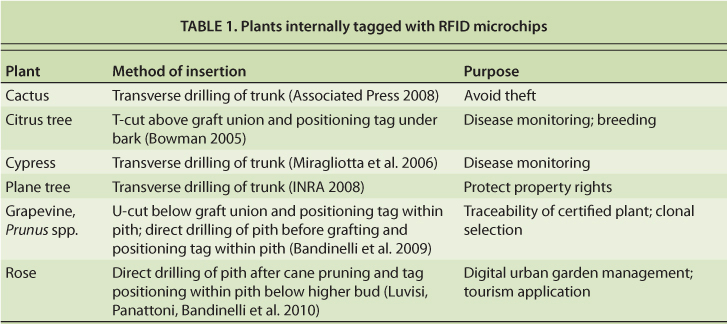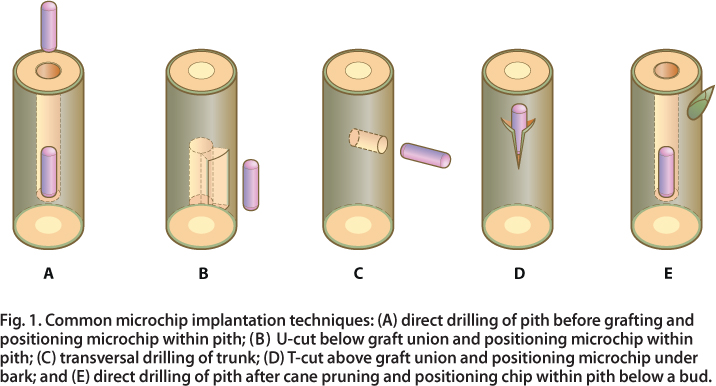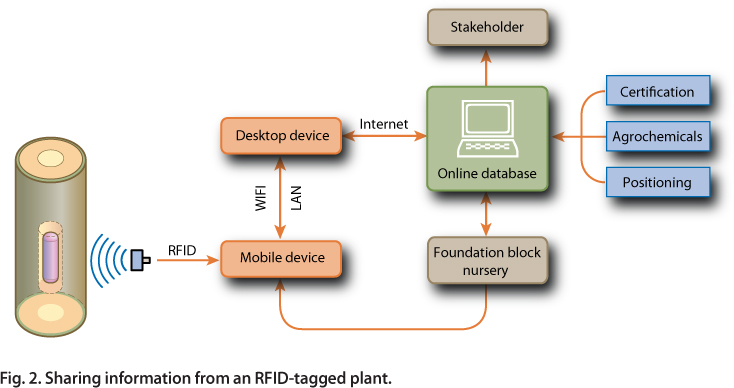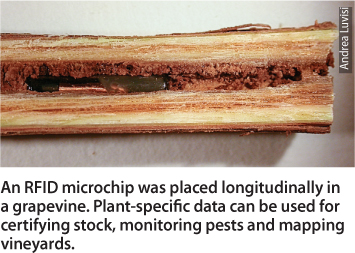All Issues
Radio-frequency identification could help reduce the spread of plant pathogens
Publication Information
California Agriculture 66(3):97-101. https://doi.org/10.3733/ca.v066n03p97
Published online July 01, 2012
NALT Keywords
Abstract
A traceable declaration of health is now necessary for many plants, especially those being monitored for disease such as certified nursery stock. Radio-frequency identification (RFID) microchips placed in woody plants can be used to store and retrieve information on their health status through all phases of propagation and in the field. The microchip is linked to a database in which many other kinds of information, such as pesticide applications, can be collected and linked. Using a Web-based platform, information can be shared globally and accessed quickly. RFID technology can also be integrated with cell phones and netbooks for the easy recording of images and audio, which can be linked back to the chip and shared — or, with global positioning systems (GPS), used to create a virtual orchard or vineyard. There are myriad uses for this new technology, which is expanding rapidly and has been implemented successfully in the European livestock industry. Trials have shown its particular relevance to plant pathology, where it could be an important risk management tool.
Full text
Product identification has become important in many aspects of agriculture. For health, sanitation and environmental safety (for example, to limit the spread of plant pathogens), government agencies now require many foods and agricultural products to have identifying labels or documents (FDA 2009). Identification also builds consumer trust; when labels and documents are lost or removed, as in the label fraud of wines, customer fidelity is at risk. Identification provides valuable information for implementing environmental protections and evaluating economic losses. It also helps control the spread of pests in propagated plant materials, which is central to international plant disease control strategies.
Radio-frequency identification (RFID) has potential uses in the production and distribution of woody plants. A microchip was implanted in a rose by drilling directly into the pith prior to grafting.
The declaration of a plant's health, or a product's high quality, should be traceable during all stages of its life. The International Organization for Standardization (ISO) defined traceability, as it applies to agricultural products, as the ability to trace and follow a food, feed, food-producing animal or ingredients through all stages of production and distribution (ISO 1994). Similar definitions have been issued by the United Nations General Assembly (United Nations 1986), U.S. Department of Agriculture (USDA 2002) and European Union (European Commission 2002).
A voluntary approach to traceability could be standardized, following international standards (ISO 2005). The identification of suppliers, participants in the production line, historic data and client feedback could all be linked to the plant or product.
Disease-free plants
In the 1960s, the European Economic Community drafted regulations regarding the health status of grapevines, ornamental plants and fruit trees, establishing protocols for producing certified pest-free plants. The North American Plant Protection Organization (NAPPO) undertook a similar approach (Hadidi et al. 1998). Among propagated woody plant crops, wine grapes are one of California's signature products in the global market (Ross and Golino 2008), and the state leads in U.S. production of peaches, nectarines (Boriss and Brunke 2006) and citrus (USDA 2007). Using plants certified as pest-free is a key strategy in preventing the spread of crop diseases in California.
The spread of leafroll disease in Napa Valley vineyards (Golino et al. 2008) and an epidemic of bacterial canker of kiwi-fruit in Italy (Ferrante and Scortichini 2010) are recent reminders of the need to limit the spread of regulated and not-yet-regulated pests and viruses (Luvisi, Panattoni, Colosimo et al. 2010). With major crops at risk, the certified propagation of disease-free stock may be an appropriate area for applying new tools in plant identification.
In plant propagating, an information technology (IT) archiving and management platform could be used by producers to track and trace material. A plant's identity — its genetic, phenotypic and health characteristics — is not only a matter of interest for plant breeders and growers, but also the public. Although awareness among plant producers regarding the risk of pathogen dispersal in plant material has increased in recent years, much still needs to be done (Janse and Wenneker 2002).
Radio-frequency identification
Radio-frequency identification (RFID) systems are composed of an electronic label, called a tag (frequently a microchip), a reader and a management system. The tag incorporates a unique identifying code received by the reader. RFID has applications for identifying humans, animals, plants and products. In humans, RFID has been studied for enhancing hospital responses to mass casualty events, to improve the traceability of medical information. The USDA established the National Animal Identification System to identify animals that have had contact with foreign or domestic animal diseases. RFID tags are put on the packaging of individual products, enabling consumers to read the tag with a reader embedded in a cell phone and download data from a website.
RFID technology has been successfully tested in agriculture for environmental monitoring, irrigation, specialty crops and farm machinery (Ruiz-Garcia and Lunadei 2011); in fruit harvest to overcome the limitations of existing yield mapping systems for manual fresh-fruit harvesting (Ampatzidis et al. 2009); in packaging to reduce fruit mixing and improve traceability (Bollen et al. 2007); and in winery fermenting vats to track sugar content and temperatures (Swedberg 2010). Companies and government agencies have been the driving forces behind this rapid development, stimulating global interest in RFID and its capabilities. In 2011, the value of the RFID market reached $5.84 billion, up from $5.63 billion in 2010 (IDTechEx 2011). The number of microchips sold grew from 1.97 billion in 2008 to 2.88 billion in 2011. The number of microchips used globally for livestock in 2011 was about 243 million. Growing markets are reflected in the falling price of microchips used for tagging: 65 cents in 2004 (CNIPA 2007) and 15 cents in 2012 (RFID Journal 2012).
In the last 10 years, some interesting solutions have been proposed to implement this technology in plant pathology.
Tagging plants
From 2005 to 2010, experimental trials focusing on inserting microchip tags have been carried out on woody plants in the United States, Italy and France (table 1). The most common tags are low-frequency (30 to 300 kilohertz) microchips. Tissue structure and trunk size have influenced implantation techniques and tag locations (fig. 1). The standardization of plant tagging does not seem likely. Different solutions have been suggested with respect to growth stage and aesthetics, while the purposes of tagging can also dictate the technology used and consequentially the method of tag insertion. For example, large tree trunks can be drilled transversally, and the pith of small trees can be drilled before grafting.
Fig. 1. Common microchip implantation techniques: (A) direct drilling of pith before grafting and positioning microchip within pith; (B) U-cut below graft union and positioning microchip within pith; (C) transversal drilling of trunk; (D) T-cut above graft union and positioning microchip under bark; and (E) direct drilling of pith after cane pruning and positioning chip within pith below a bud.
Grapevines and fruit trees.
The optimal time for a certified plant to be tagged is as early as possible. To achieve this target for certified grapevines and fruit trees, the preferred place for the microchip is in the pith of the rootstock, installed using one of two procedures (Bandinelli et al. 2009). The first procedure involves direct-drilling the pith from the distal cut of the rootstock just before grafting, then installing the microchip below the grafting point (fig. 1A). The alternative procedure consists of a U-cut performed laterally on the rootstock below the grafting point, from the bark through to the pith (fig. 1B); in this procedure, the microchip is installed inside the pith and cut tissues are manually reassembled.
Large trees.
For large-caliper trees such as the mature Cypress species, the depth and position of drilling to insert tags had no influence on damage to the trees (Miragliotta et al. 2006) (fig. 1C). To monitor the health status of each tree, the tag included a tree identification number. This data was stored in a digital database and linked to tree positioning and health observations, similar to systems used for livestock identification.
Small trees.
Different methods are required to tag smaller trees, such as those typically found in nurseries producing certified disease-free stock. A report on microchip implantation in citrus at the nursery stage described a tagging procedure that was reliable, durable and secure (Bowman 2005). An upright T-cut was made above the graft union during active tree growth, followed by an insertion procedure similar to budding (fig. 1D). The signal penetration varied significantly depending on the scanning device (for example, AVID Power Tracker II doubled the reading distance of AVID Breeder Reader) and, in a more limited way, on the wood type (signals penetrated better in pine than oak wood). Microchips can be read in most woody plant species for 10 years or more when appropriate RFID scanners are selected, as confirmed by later tests (Bowman 2010).
Ornamentals.
Ornamental shrubs such as roses can also be tagged (fig. 1E). Rose canes with a diameter of one-third inch are most suitable; in smaller diameter canes, wilt of the lateral shoot and growth detriments were observed (Luvisi, Panattoni, Bandinelli et al. 2010).
External tagging.
Implanting microchips is the best way to tag certified plants, but RFID tags can be placed outside plants using a relatively inexpensive electronic barcode system. Rectangular plastic tags (1.2 by 1.2 inches) were attached to trees using a monofilament line, or a microchip was attached externally using a plastic wristband. This approach is useful for recording and retrieving data from plant samples. External tags are simple, inexpensive and can be attached at any stage of plant growth, but they can also be removed or damaged more easily.
Kumagai and Miller (2006) studied the use of barcodes in a tropical environment. The barcodes maintained their readability under a variety of environmental conditions, including temperatures ranging from −112°F to 212°F and immersion in liquid nitrogen and other liquids. The tags could also be autoclaved (sterilized).
Database links
Microchips without large memory capacity must be interfaced to a database (fig. 2); the code in each tag is useless for traceability unless it is linked to other information. For a certified disease-free plant, the tag can be linked to health observations, plant specifics (genetic and phenotypic characteristics, positioning) and certification and treatment specifics (agrochemicals and dates of treatment), which are then recorded in datasheets and stored in the online database. The tag code of the plant is required to access the database. Codes can be read from a tagged plant using a mobile device, granting (directly or via a desktop device) access to the online database. Different users such as workers in foundation blocks and nurseries and other stakeholders can be identified and a privilege-access system developed to grant access for various uses. For example, a nursery workers can create or edit the datasheets that refer to products, while agricultural agencies or researchers can view fields regarding health status and treatments.
In other applications, the database can be used to support product performance claims, track pesticide and fertilizer use, detail production costs and establish field histories. If pesticide complaints are made against a producer, good records such as those possible with this kind of database are almost always beneficial (PEI 2003). Peets et al. (2009) reported on the tracking and application of agrochemicals and suggested using RFID microchips in an automatic recording system for traceability. RFID tags were attached to physical containers of products, and essential information tracked included the country of registration, chemical type, unique registration number of agrochemicals, container size, specific gravity, unit of measure and a digital signature.
An RFID microchip was placed longitudinally in a grapevine. Plant-specific data can be used for certifying stock, monitoring pests and mapping vineyards.
With a database designed for tracking RFID-tagged grapevines from the nursery stage, RFID codes can be digitally entered into the search field and the user can view datasheets on the tagged plants detailing all customers along the production line (Luvisi, Triolo et al. 2010). Datasheets can be considered a sort of electronic identity card (eID) for individual plants. A similar system has been tested for certified citrus plants (Porto et al. 2011).
Many kinds of data can be linked to the eID. In an urban forest context, geospatial tools such as global positioning systems (GPS) and geographic information systems (GIS) can provide timely and extensive spatial data from which attributes such as land cover, forest structure, species composition and condition, heat island effects and carbon storage can be derived (Ward and Johnson 2007). GIS can locate tagged plants on an electronic map, recreating a virtual vineyard or orchard (Luvisi et al. 2011). This feature can be used for management, monitoring or teaching. For marketing, a vineyard or orchard could be remotely shown to stakeholders or consumers on a website and the link placed on product labels.
Web links
Researchers have studied the transfer of information via the Web for agriculture and plant health monitoring since the 1990s. Using Web applications to collect information on the sanitary status of plants allows for rapid communication to prevent the spread of pathogens. The U.N. Food and Agriculture Organization (FAO) has introduced global information sharing and collaboration between users via the Web, and the FAO Agricultural Information Management Standards (AIMS) system provides a platform to disseminate standards and good practices in information management in support of the right to food, sustainable agriculture and rural development. The European Forest Information System (EFIS) includes elements that allow the searching of metadata catalogues and the importing of identified data for exploratory analysis (Schuck et al. 2005). A database with Web interface was specifically designed for plant-associated and plant-pathogenic microorganisms. The Plant-Associated Microbes Database (PAMDB) comprises data from multilocus sequence typing and analysis studies (Almeida et al. 2010).
RFID-based technologies can be implemented in platforms to share and manage information in agriculture, providing a safe and durable link between plants and information (Sørensen et al. 2010). A conceptual model was developed based on soft systems methodology and information derived from four pilot farms, representing diverse conditions across the European Union. This research showed the benefits of dedicated system analysis methodologies as a preliminary step toward the actual design of a novel farm management information system, compared with other more rigid and activity-oriented system analysis methods.
RFID systems can be compared to Web 2.0, which allows data to be controlled by users. A collaborative Web 2.0–based workspace was used to support research data management and interaction, allowing useful data interchange and communications between plant pathology researchers conducting long-term trials on the sanitary selection of grapevines (Luvisi et al. 2012). Laboratories might use RFID to share information about plant or sample types and the results of assays involved in trials, although at present these applications are limited. RFID could represent a useful starting point for a more in-depth computerization of plant research and health monitoring practices.
Integration with a Web-based system was recently reported in agriculture with the FARMA platform (Voulodimos et al. 2010). The platform introduces the use of rewritable tags for storing information, which can identify lost animals or even recognize the animal's basic information without contacting the related database.
Mobile links
Kumagai and Miller (2006) reported using barcode tags and mobile devices to manage plant pathology samples. A novel electronic barcode system that uses RFID tags, cell phones and portable computers to link phenotypic, environmental and genomic data was developed. RFID tags were used in outdoor field trials in Hawaii, attaching the tags to mango trees with monofilament line or wristbands.
An RFID barcode tag containing sanitary, phenotypic, environmental and genomic data was linked to a Multimedia Messaging Service (MMS) system, allowing the data to be recorded and retrieved using a cell phone. Researchers were able to take photographs of plant samples and record and link audio information about their work to the image. The name of the image and audio file was then changed to an RFID code and entered into the cell phone's contact database. Then files were sent to a personal email account via cell phone MMS with the RFID code as the subject line. The cell phone had also been set to record a GPS reading and date. The RFID reader was switched to writing mode, and the information was recorded to the RFID barcode. A system to transfer the RFID data to an external database was also developed.
With RFID, geographic information systems (GIS) can be used to locate plants on an electronic map, creating a virtual vineyard or orchard. Google Earth was utilized to show the locations of grapevines marked by an RFID system.
Mobile devices such as netbooks, tablet PCs and smart phones are optimal instruments for consulting and updating a virtual orchard or vineyard from the field; by pointing a mobile device to a tag, the viticulturalist may download climatic data or upload information such as disease and pest incidence, without having to provide coordinates or any other references and without having to return to a central office (Cunha et al. 2010). Unfortunately, widespread implementation of this technology has not been reported, suggesting difficulty in updating IT systems in agriculture.
Implementation challenges
The IT revolution has made traceability, logistics and monitoring economically feasible for food products in the agricultural product supply chain. Electronic identification has been implemented in livestock farming (Stumbos 2005), but applying the technology to plants has not taken off. The cost of microchips may be the main limitation, although they may be affordable now for high-value certified plants such as grapevines. Unfortunately, there is no data on the cost of training operators to properly place RFID in plants or the loss rate of microchips and plants during implanting. Other limitations include the low level of computerization on farms and the lack of urgent reasons to make the change.
For the livestock industry, RFID has proven useful for avoiding and managing outbreaks of animal diseases and foodborne illness. In 2008, the California Department of Food and Agriculture used individual animal RFID tags to control bovine tuberculosis. The USDA's National Animal Identification System (NAIS) is a voluntary program intended to allow the tracking of specific animals by assigning each a unique identification number. The tags used by NAIS participants need not include RFID technology, but many are employing RFID-enabled tags to track the cattle as they move through the supply chain. In 2007, the European Council mandated that each member state must establish a system for the identification and registration of ovine and caprine animals.
Woody plants such as grapevines and orchard stock cause less concern about human health than animals, and a cost-benefit analysis (including the cost of tags and industry restructuring) has not been done for woody plants. Yet RFID might be a useful tool for managing risks related to the environmental impacts of production systems, chemical residuals and the worldwide spread of plant pathogens (in particular, viruses). In certified plant propagation and breeding programs, risk management may be sufficient reason to change to an RFID system. The loss, removal or damage of traditional plant labels at any stage of production can result in a mother plant that has no known history, which is especially problematic because of the many viruses, viroids, phytoplasmas and other systemic pathogens that can infect propagative material.










